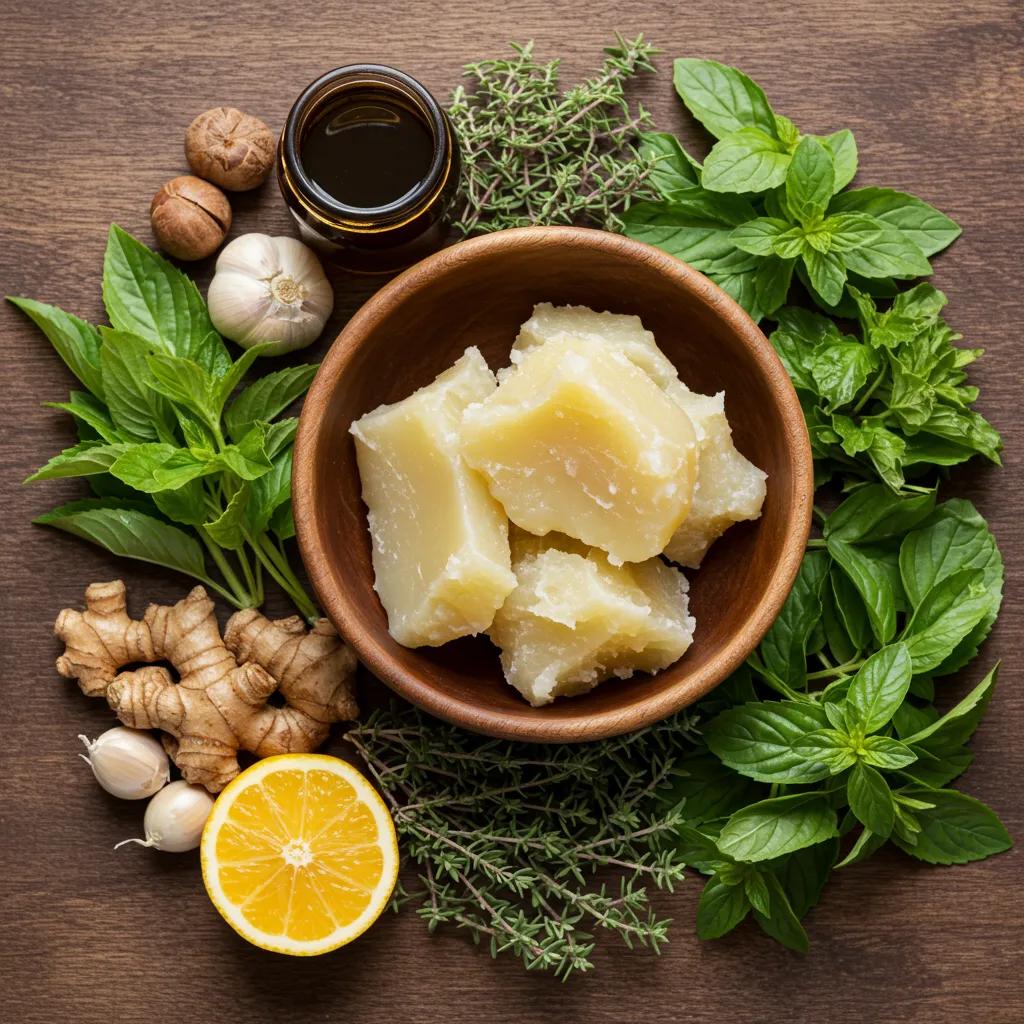Rejuvenating hair from root to tip begins with nourishing ingredients proven by ancestral beauty traditions. Many hair treatments leave behind residue rather than strengthen follicles, leading to dryness, breakage, and scalp imbalance.
Tallow offers a nutrient-dense solution rich in fat-soluble vitamins and essential fatty acids that restore scalp health and support robust hair growth. This guide explains what tallow is, how it stimulates follicles, its relief for common conditions, practical application methods, and a comparison with other natural oils.
What Is Tallow and What Are the Tallow Benefits for Hair?
Tallow is rendered beef fat processed to preserve its nutrient profile for skin and hair applications. Its rich composition mimics scalp sebum and delivers concentrated vitamins that nourish hair follicles. For centuries, traditional practitioners have relied on tallow’s restorative properties to maintain scalp balance and strand integrity.
What Nutrients Does Tallow Contain That Support Hair Health?

Tallow contains fat-soluble vitamins and fatty acids that support follicle function and strand resilience.
| Nutrient | Function | Benefit |
|---|---|---|
| Vitamin A | Cell turnover regulation | Promotes healthy hair growth |
| Vitamin D | Follicle cycle support | May support hair follicle health |
| Vitamin E | Antioxidant protection | Shields scalp from oxidative stress |
| Vitamin K | Scalp healing | May soothe irritation |
This nutrient profile lays the foundation for tallow’s deep conditioning action and leads into its absorption dynamics.
Tallow's Nutrient Composition and Hair Health
Research indicates that tallow, rich in fat-soluble vitamins like A, D, E, and K, can contribute to hair health. These vitamins play roles in promoting hair growth, reducing shedding, protecting against oxidative stress, and soothing scalp irritation. The presence of essential fatty acids further supports follicle function and strand resilience.
Draelos, Z. D., Journal of the American Academy of Dermatology (2007)
This research supports the article's claims about the specific vitamins and fatty acids found in tallow and their benefits for hair.
How Does Tallow Mimic Natural Scalp Oils for Better Absorption?
Tallow’s fatty acid ratio closely parallels human sebum, allowing it to penetrate hair cuticles and skin layers without clogging pores. Its stearic and palmitic acids spread evenly, enhancing scalp hydration and creating a protective barrier that eases nutrient delivery to hair roots.
Why Is Grass-Fed and Ethically Sourced Tallow Better for Hair?
Grass-fed tallow provides higher levels of conjugated linoleic acid and omega-3 fatty acids compared to grain-fed sources. Ethically sourced fat is free from antibiotics and hormones, ensuring purity that supports scalp microbiome balance while reinforcing sustainable farming practices.
How Does Tallow Promote Hair Growth and Strengthen Hair?

Tallow may stimulate hair growth by delivering vitamins that support follicles and fatty acids that fortify the hair shaft. This dual action supports both initiation of new strands and long-term strand resilience.
How Do Vitamins A, D, E, and K in Tallow Stimulate Hair Follicles?
Vitamins in tallow support cell renewal and promote follicle health.
- Vitamin A regulates sebum production to help prevent dryness.
- Vitamin D may encourage dormant follicles to enter growth phase.
- Vitamin E boosts micro-circulation for oxygen and nutrient delivery.
- Vitamin K aids scalp repair to maintain follicle integrity.
These combined actions help ensure follicles remain nourished and active, preparing the way for stronger growth.
What Role Do Fatty Acids Play in Enhancing Hair Strength and Elasticity?
Oleic, palmitic, and stearic acids penetrate the cuticle to lock in moisture and reduce porosity. This fatty acid blend enhances strand elasticity and may minimize breakage under styling stress.
The Role of Fatty Acids in Hair Health
Fatty acids, such as oleic, palmitic, and stearic acids, are essential for maintaining hair health. They penetrate the hair cuticle, locking in moisture and reducing porosity, which enhances elasticity and may minimize breakage. This process is important for maintaining the strength and manageability of hair.
Can Tallow Improve Scalp Circulation to Support New Hair Growth?
Massaging tallow into the scalp may increase blood flow through gentle mechanical stimulation. Improved circulation delivers oxygen and amino acids to hair roots, creating an environment that can support new growth.
How Can Tallow Help with Common Scalp and Hair Conditions?

By combining anti-inflammatory fatty acids and soothing vitamins, tallow may address dryness, flaking, and texture issues at their source. This restorative action can bring scalp balance and revitalized hair appearance.
Does Tallow Relieve Dry Scalp, Dandruff, and Irritation?
Tallow’s stearic acid has anti-inflammatory properties while vitamin E protects against oxidative damage. Its occlusive layer seals moisture and may relieve itching, potentially reducing dandruff flare-ups.
How Does Tallow Reduce Frizz and Improve Hair Texture?
Tallow coats each strand with a thin lipid film that smooths the cuticle and controls humidity-driven swelling. Enhanced slip and shine make hair more manageable and resilient to environmental stress.
Can Tallow Repair Damaged or Thinning Hair?
The nutrient-rich profile of tallow supports keratin synthesis and cuticle repair. Regular treatments may rebuild weakened areas, reinforcing thinning sections and helping prevent split ends from advancing.
What Are the Best Ways to Use Tallow for Hair Care?
Optimal tallow use balances concentration with application method to maximize benefits without greasiness. Practical routines integrate masks, leave-in balms, and scheduled treatments.
Ready to explore the full range of tallow hair care options? Browse all tallow-based products to find the perfect match for your hair.
How Do You Apply Tallow Hair Masks and Conditioners Effectively?
- Warm a small amount between palms until melted.
- Distribute from scalp to ends, focusing on dry zones.
- Wrap hair in a warm towel and leave for 20–30 minutes.
- Rinse with a gentle shampoo to remove residue.
This process helps vitamins and fatty acids penetrate deeply before cleansing, revealing softer, stronger hair.
Can Tallow Be Used as a Leave-In Treatment or Scalp Balm?
Tallow can be used as a lightweight leave-in sealant when applied sparingly to damp ends or irritated patches. A pea-sized amount smooths flyaways and calms hotspots without weighing hair down.
How Often Should You Use Tallow for Optimal Hair Results?
Weekly mask treatments and bi-weekly scalp balms can maintain hydration and follicle stimulation. Adjust frequency based on hair density and oil production to avoid buildup and preserve natural balance. Visit our blog for fresh tallow care updates and other tips.
How Does Tallow Compare to Other Natural Hair Oils?
A comparative analysis highlights tallow’s unique nutrient density and cuticle-friendly profile versus plant-based oils.
| Hair Oil | Key Benefit | Nutrient Profile |
|---|---|---|
| Tallow | Follicle nourishment | Vitamins A, D, E, K; CLA |
| Coconut Oil | Surface hydration | Medium-chain triglycerides |
| Argan Oil | Shine enhancement | Vitamin E; linoleic acid |
| Jojoba Oil | Sebum regulation | Wax esters similar to sebum |
What Are the Advantages of Tallow Over Coconut, Argan, and Jojoba Oils?
Tallow delivers higher concentrations of fat-soluble vitamins and offers improved follicle penetration due to its sebum-like composition, whereas coconut and argan oils primarily coat the hair shaft.
Are There Any Drawbacks or Greasiness Concerns with Tallow?
Heavy application can lead to buildup on fine or oily hair. Using minimal amounts and thorough rinsing prevents residue and maintains a balanced scalp environment.
Which Hair Types Benefit Most from Tallow Compared to Other Oils?
Coarse, curly, and chemically treated hair types may gain the most from tallow’s deep conditioning and repair properties, while finer hair may require lighter application to avoid weighing down strands.
Tallow provides an ancestral, nutrient-rich approach to scalp care and strand strengthening that modern botanical oils cannot fully replicate. Readers seeking a natural, sustainable solution may find tallow a valuable ally in achieving healthier, more resilient hair.
Looking for a Tallow-Based Product for Your Hair?
If you’re ready to experience the benefits of tallow for yourself, we recommend The Mane Bee. This versatile product works as a beard balm, hair pomade, or curl tamer.
Tallow isn’t just amazing for hair—it’s also deeply nourishing for skin. If you’re interested in how tallow can support skin recovery and balance, especially after pregnancy, we recommend reading our Postpartum Skin Care Guide. This guide walks you through safe, natural ways to care for your skin using tallow’s restorative benefits.
